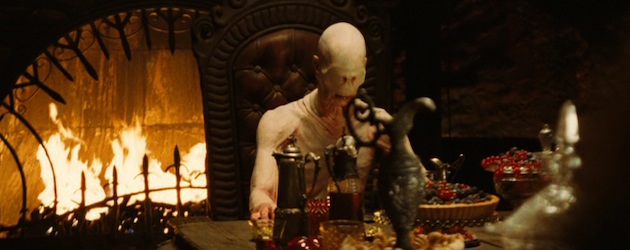Eugenio Caballero

All of these decisions are important in making the audience feel what the character is feeling. My personal taste changes over the years -I don’t have the same taste that I did twelve years ago. But what I can use instead, to understand if a visual decision works or not, is I can ask if it’s truthful to the story and truthful to the characters. What are they feeling? That’s very important. As designers we have a lot of tools to transmit those feelings.
Color for me is also a very important thing. In The Limits of Control, the Jim Jarmusch movie that we shot in Spain some years ago, we started with this man who has been assigned to go and find certain people and accomplish a mission. In order to accomplish this mission he had to break into a heavily-guarded house. We decided that as that character starts his quest and meets these marvelous characters along the way and talks about all these strange subjects, he’s gradually becoming a ghost. He’s leaving all his baggage from the beginning behind so that he’ll be so light, in a metaphorical way, that he’ll be able to break into that house.
So we started with a very, very saturated palette. You can see in the beginning, when he starts in Madrid, the bars, the apartment, all the locations are all full of really saturated blues, oranges, reds. Then as he’s walking this palette becomes less and less saturated. When he’s in Seville there are warmer colors but less bright and less shiny and then when he gets to Almeria, which is the place where this house is, everything is earth-tones with a lot of white. Desaturated colors. We lose the colors as he’s walking in order to accomplish that mission. Then when he accomplishes his mission and he goes back to real life he reclaims his colors. There’s a scene in which he changes clothes in a bathroom that has saturated colors again. He puts on a lime-green jacket and then takes some escalators, which are again blue and red and then he comes back to life. We worked closely with Christopher Doyle [the DP] on that palette so we could be completely coordinated.
AS: Do you always work very closely with the DP?
EC: I try to, yes. Normally I collaborate a lot with the DP. It’s strange because most of the time the production designer starts before the DP. Since you have a longer preproduction, and you start making drawings, notes and concepts before that, you often start working directly with the director. When the DP comes into the project we discuss the things we’ve been working on. He adds his input and I’m very open to his contributions and very happy to discuss everything with him.
I’m a big believer in these creative discussions and the creation of concepts. If you create those concepts in the beginning with the director and the DP, when it’s preproduction, then all of us are better suited to make decisions later and understand if those decisions are correct or not. Even if you have to answer seven hundred questions a day. It’s very easy to give an incorrect answer when you’re working at such an intense pace so for me the most important thing is to first create the frame of design for the film. That obviously also changes sometimes during the process.